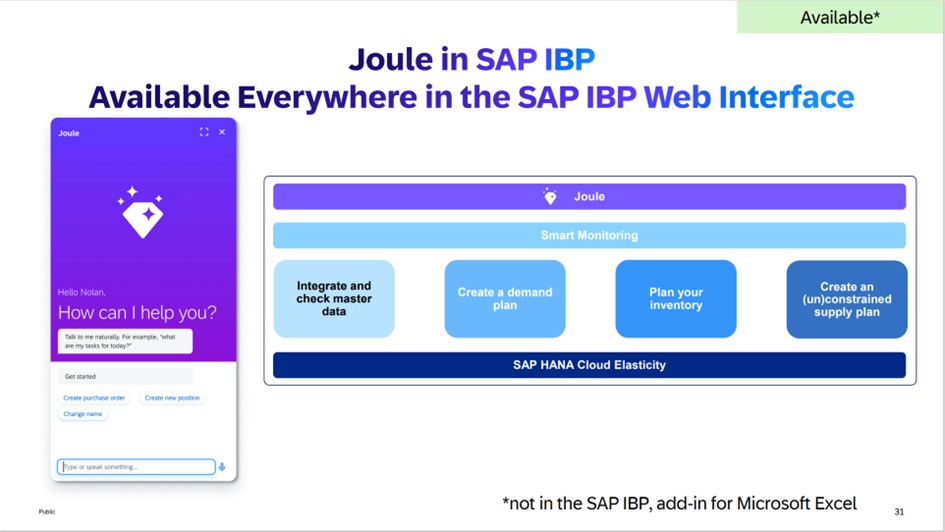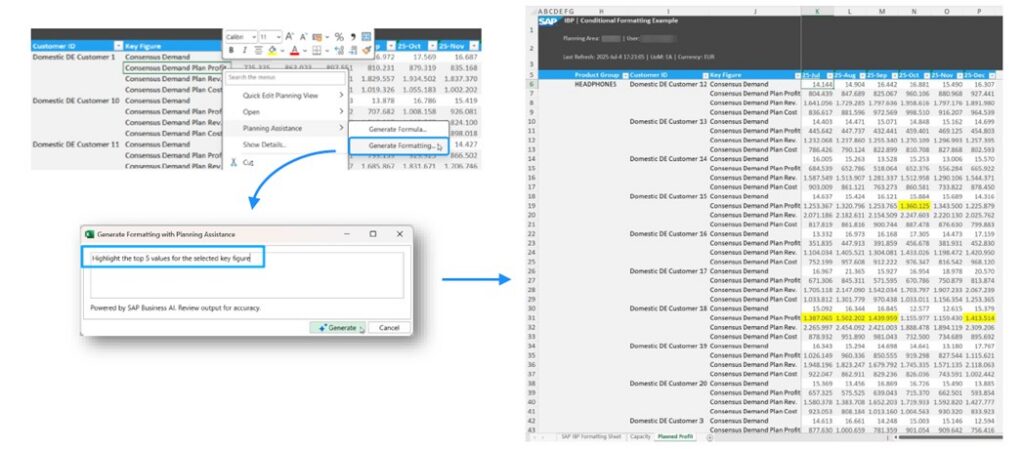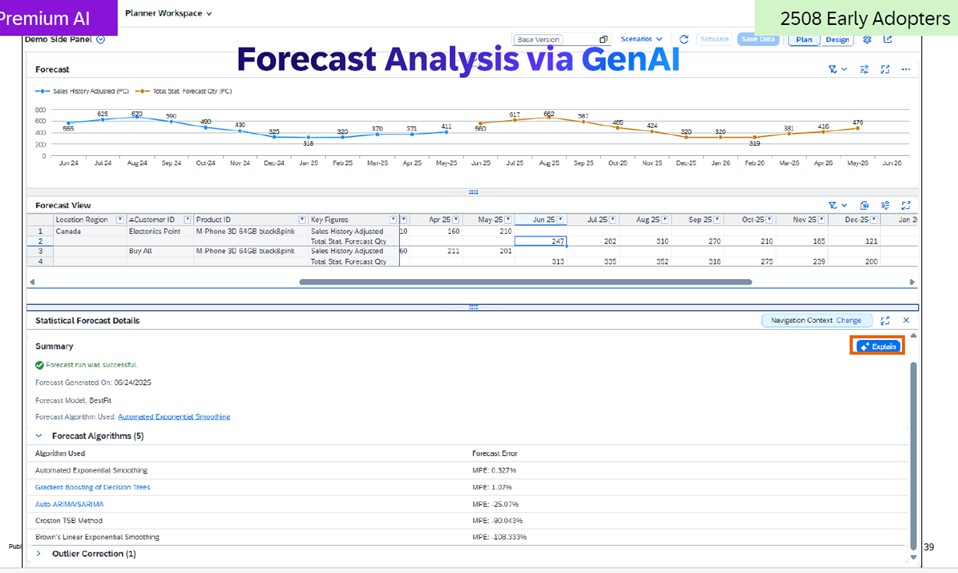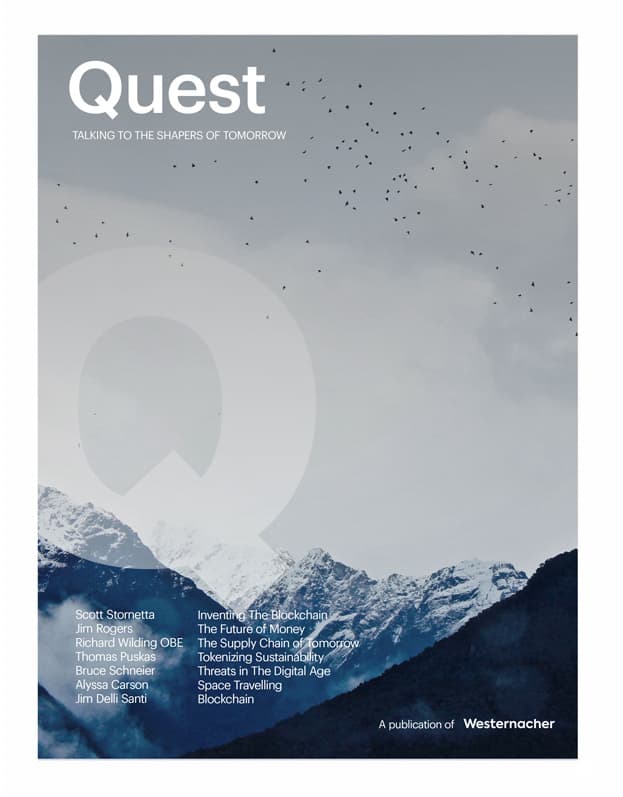Share this article
Follow us on Linkedin
This update brings powerful new capabilities, particularly in Artificial Intelligence, that are designed to make our planning processes smarter, faster, and more intuitive.
These advancements will transform our daily tasks, affecting everything from Excel data interactions to comprehending complex supply chain dynamics. Here’s a quick overview of the top 5 highlights:
Top 1: Comprehensive AI Revolution in IBP.
SAP IBP 2508 marks a leap forward by embedding powerful Artificial Intelligence across the entire platform. This AI revolution is designed to automate complex tasks, provide deep insights, and make every user more productive, transforming how you interact with supply chain data.
SAP IBP 2508 significantly expands AI usage across planning. Customers can now benefit from:
- Running Jobs with Joule – trigger planning jobs directly through natural language commands.
- Check Master Data Health– identify missing or inconsistent master data with AI assistance.
- Let Excel create formulas for you– just describe calculations in plain language, and the system generates the formula.
- Instantly highlight risks & opportunities – quickly create formatting rules to highlight important values.
- Understand your forecasts – automatically summarize forecast results, explain why the forecast looks the way it does, and suggest improvements.
- Inventory Analysis via GenAI – highlight the key drivers of inventory levels, such as demand variability or lead-time changes, in an easy-to-understand explanation.
Top 2: AI Assistant in Excel Add-in.
This feature brings the power of generative AI directly into the planner’s most familiar tool—Microsoft Excel. It transforms tedious manual work into simple conversation, significantly boosting productivity and reducing errors.
- Create Formulas with AI: Instead of writing complex expressions, planners can type their intent. For example, typing “calculate the difference between sales forecast and actuals” will automatically generate the correct formula.
- Conditional Formatting with AI: Visualize critical issues instantly by describing them. A command like “highlight all products where inventory is below safety stock” applies the formatting rule across the entire dataset immediately.
Top 3: AI-Driven Insights for Forecasting & Inventory.
Move beyond traditional reports to AI-generated narratives. These features provide plain-English explanations and diagnostic insights that help planners understand the “why” behind the numbers, leading to faster and more confident decision-making.
- Forecast Analysis via GenAI: while viewing a product/location/time combination you can open the forecast details and ask the system to explain what the statistical forecast did (trend detection, outliers, drivers), it also provides a summary explaining why a specific algorithm was chosen as the best fit and offers recommendations to potentially improve forecast accuracy.
- Inventory Analysis via GenAI: AI-assisted Inventory Analysis: The GenAI solution dissects multi-echelon inventory optimization results and summarizes them in Excel, clearly explaining the key drivers behind safety stock recommendations—such as demand variability, service level gaps, and lead time uncertainty—in an easy-to-understand manner. This process highlights main drivers and actionable insights while making complex calculations transparent.
Top 4: New Harmonized Planning Area.
What is HPA (I_SAPIBP2)?
HPA (the new I_SAPIBP2 planning area) harmonizes time-series and order-based planning on a single model: one set of master data, one mapping, support for both time buckets and short/mid term order planning. It simplifies configuration and reduces master-data duplication. 2508 provides the initial HPA template and an early-adopter adoption program; migration tooling for existing customers is planned for 2026 (IBP 2602 window). The guidance in 2508 recommends HPA for greenfield or those integrating tactical & operational planning now; brownfield customers will get migration tooling later.
The new harmonized planning area Integrated Business Planning (I_SAPIBP2) is also available in SAP best practice for IBP 2508.
Actionable guidance.
- For greenfield projects: consider HPA now to avoid later migration
- For existing IBP: start planning your migration strategy and follow SAP’s migration program (tooling expected 2026)
- Integration implication: HPA expects RTI for S/4 and CI for other integrations — plan integration architecture accordingly.
Top 5: New Integration Methods: RTI & CI as the New Standard.
In 2508, SAP makes integration between IBP and other systems simpler and faster.
- RTI (Real-Time Integration) is recommended when you connect IBP with S/4HANA or ECC. It allows changes in orders, stock, or production plans to flow in real time, reducing delays and manual updates.
- Cloud Integration (part of SAP Integration Suite) is the preferred option when you need to connect IBP with non-SAP systems or run larger data loads in batches.
Together, RTI and Cloud Integration give customers a clear path forward — real-time where it matters, batch where it fits.
Note: SAP is moving focus away from SDI (Smart Data Integration). If you are still using SDI, please plan to shift to the new recommended tools in the future.
P.S. Please check the detailed description per change in What’s New Viewer .








